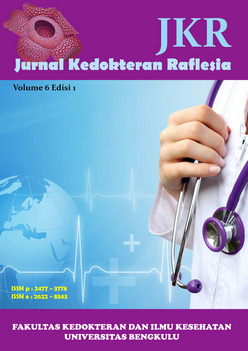Main Article Content
Abstract
Conclusion: There is a significant relationship between environmental sanitation and malaria in the working area of Sidomulyo Health Center, Gading Cempaka District, Bengkulu City with p = 0.022, c = 0.011.
Keywords: Environmental Sanitation, malaria incidence
Keywords
Article Details
Authors who publish with this journal agree to the following terms:
- Authors retain copyright and grant the journal right of first publication with the work simultaneously licensed under a Creative Commons Attribution License that allows others to share the work with an acknowledgement of the work's authorship and initial publication in this journal.
- Authors are able to enter into separate, additional contractual arrangements for the non-exclusive distribution of the journal's published version of the work (e.g., post it to an institutional repository or publish it in a book), with an acknowledgement of its initial publication in this journal.
- Authors are permitted and encouraged to post their work online (e.g., in institutional repositories or on their website) prior to and during the submission process, as it can lead to productive exchanges, as well as earlier and greater citation of published work (See The Effect of Open Access).
References
- Noor, Nasri. (2007) . Dasar Epidemiologi. Jakarta: PT Rineka Cipta .
- Depkes, RI. (2005). Pedoman pelaksanaan Program Pelaksanaan Penyehatan Lingkungan Pemukiman Repelita V. Jakarta: Ditjen PPM dan PLP.
- Dinas Kesehatan Bengkulu. (2015). Profil Kesehatan Provinsi Bengkulu . Bengkulu.
- Chandra, B. (2006). Pengantar Kesehatan Lingkungan. Jakarta: EGC.
- Prabowo, Arlan. (2004). Malaria, Mencegah dan Mengatasinya. Jakarta :Puspa Swara.
- Depkes, RI. (2003). Pedoman Tatalaksana Kasus Malaria, Gebrak Malaria. Jakarta: Ditjen PPM dan PLP.
- Kusnindar. (2000). Masalah Malaria dan pemberantasannya di Indonesia. Jakarta: Cermin Dunia kedokteran. Vol.63:7-12
- Slamet, Juli, Soemirat. (2004). Kesehatan Lingkungan. Yogyakarta: Gadjah Mada Universiti Press.
- Imran, Wahid. (2017). Faktor-faktor yang Mempengaruhi Kejadian Malaria di Puskesmas Pekik Nyaring Kabupaten Bengkulu Utara. (Skripsi). Bengkulu :Universitas Muhamadiyah Bengkulu.
- Bustam M.,N. (2007). Pengantar Epidemiologi . Jakarta: PT. Rineka Cipta
- Hayani, Elvi, Putranto, Agus, Harsono, Puji. (2012). Hubungan Antara Kasus Malaria Dengan Sanitasi rumah Tempat Tinggal di Puskesmas Pasar Manna Kabupaten Bengkulu Selatan. Jurnal Penelitian Pengelolaan Sumberdaya Alam dan Lingkungan NATURALIS.Vol.1(1): 12-18
References
Noor, Nasri. (2007) . Dasar Epidemiologi. Jakarta: PT Rineka Cipta .
Depkes, RI. (2005). Pedoman pelaksanaan Program Pelaksanaan Penyehatan Lingkungan Pemukiman Repelita V. Jakarta: Ditjen PPM dan PLP.
Dinas Kesehatan Bengkulu. (2015). Profil Kesehatan Provinsi Bengkulu . Bengkulu.
Chandra, B. (2006). Pengantar Kesehatan Lingkungan. Jakarta: EGC.
Prabowo, Arlan. (2004). Malaria, Mencegah dan Mengatasinya. Jakarta :Puspa Swara.
Depkes, RI. (2003). Pedoman Tatalaksana Kasus Malaria, Gebrak Malaria. Jakarta: Ditjen PPM dan PLP.
Kusnindar. (2000). Masalah Malaria dan pemberantasannya di Indonesia. Jakarta: Cermin Dunia kedokteran. Vol.63:7-12
Slamet, Juli, Soemirat. (2004). Kesehatan Lingkungan. Yogyakarta: Gadjah Mada Universiti Press.
Imran, Wahid. (2017). Faktor-faktor yang Mempengaruhi Kejadian Malaria di Puskesmas Pekik Nyaring Kabupaten Bengkulu Utara. (Skripsi). Bengkulu :Universitas Muhamadiyah Bengkulu.
Bustam M.,N. (2007). Pengantar Epidemiologi . Jakarta: PT. Rineka Cipta
Hayani, Elvi, Putranto, Agus, Harsono, Puji. (2012). Hubungan Antara Kasus Malaria Dengan Sanitasi rumah Tempat Tinggal di Puskesmas Pasar Manna Kabupaten Bengkulu Selatan. Jurnal Penelitian Pengelolaan Sumberdaya Alam dan Lingkungan NATURALIS.Vol.1(1): 12-18
